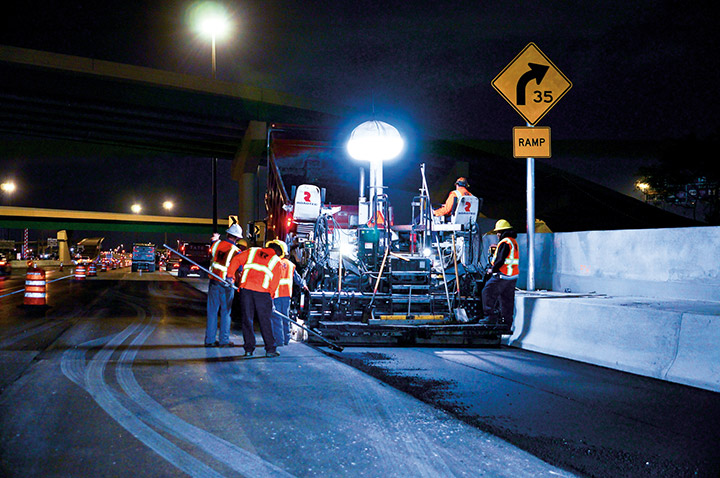Unlocking the Tricks of Hot Mix Asphalt Modern Technology
Checking out the depths of warm mix asphalt modern technology reveals a globe where precise formulas and meticulous procedures converge to shape our roads and infrastructure. The fusion of fillers, binders, and accumulations isn't simply a building task however a calculated orchestration of toughness and performance. As we peer right into the elaborate dance of components, a tapestry of resilience and sustainability unravels. What exists underneath this surface of asphaltic mastery, and what keys wait to be introduced in the realm of paving technologies?
Relevance of Warm Mix Asphalt
Warm Mix Asphalt plays a critical duty in contemporary infrastructure growth because of its resilience and cost-effectiveness. As one of the most frequently used paving product for roadways, freeways, and parking area, Warm Mix Asphalt provides an array of advantages that add to its relevance in building tasks. One crucial benefit is its capability to hold up against rush hour lots and rough climate condition, supplying a trusted and durable surface for transportation networks. Furthermore, Warm Mix Asphalt is cost-effective in both preliminary building and construction and long-term maintenance, making it a favored selection for many facilities jobs.
The durability of Warm Mix Asphalt stems from its structure, which includes aggregates, binder, and filler products that are very carefully chosen and blended to fulfill certain performance demands. In general, the importance of Warm Mix Asphalt in facilities development can not be underrated, as it continues to be a cornerstone of contemporary building practices.
Elements of Asphalt Mixes
The make-up of asphalt mixes consists of meticulously selected aggregates, binder, and filler materials that are critical for achieving certain efficiency requirements. Aggregates are the main part of asphalt blends, providing strength and stability. The binder, normally asphalt or asphalt concrete, holds the aggregates together and offers versatility and longevity to the mix.
The combination and proportion of these components play a considerable function in establishing the top quality and efficiency of the asphalt mix. Designers carefully develop the mix to satisfy specific requirements, thinking about variables like traffic volume, climate problems, and sidewalk lifespan. Proper selection and harmonizing of accumulations, binder, and fillers are essential for creating durable, long-lasting asphalt pavements.
Combining and Manufacturing Methods

As soon as the accumulations are picked, the binder, frequently asphalt cement, is contributed to bind the materials together. The binder's high quality and quantity substantially influence the mix's adaptability, resistance, and toughness to ecological aspects. Furthermore, fillers like hydrated lime or Portland cement might be included to boost certain attributes of the asphalt mix, such as its workability or wetness resistance.
During production, the aggregates and binder are warmed, commonly in between 250-325 ° F(121-163 ° C ), to assist in mixing and guarantee proper coating of the accumulations. The blending procedure needs to be complete to accomplish a homogeneous mixture that advertises the wanted performance qualities of the asphalt. Various strategies, such as set mixing or drum blending, are utilized to accomplish consistent and high-quality asphalt blends for building projects.
Factors Influencing Asphalt Performance
Variables influencing asphalt efficiency incorporate a range of variables that affect the durability, durability, and total quality of asphalt sidewalks. One vital factor is the high quality of products used in the asphalt mix.

Style factors to consider, such as sidewalk thickness and drain, are crucial in ensuring the long-lasting efficiency of the asphalt sidewalk. By meticulously considering these professionals, aspects and designers can enhance asphalt performance and improve the service life of pavements.
Lasting Practices in Asphalt Modern Technology

WMA permits go to website for the production and positioning of asphalt mixes at reduced temperatures compared to traditional hot-mix asphalt, resulting in minimized energy usage and greenhouse gas exhausts. The use of permeable asphalt mixes can assist mitigate stormwater overflow concerns by allowing water to penetrate via the pavement and right into the ground, advertising natural water purification and recharge processes.
Verdict
In conclusion, hot mix asphalt innovation plays a crucial role in contemporary facilities growth as a result of its resilience and cost-effectiveness. By meticulously stabilizing parts, employing proper mixing techniques, and thinking about different elements, engineers can produce top notch asphalt blends that hold up against rush hour lots and rough climate problems. Welcoming lasting techniques, such as making use of recycled products and warm-mix modern technologies, additionally improves the environmental friendliness of asphalt innovation.
Mixing and production techniques in warm mix asphalt modern technology include the accurate combination and processing of accumulations, binder, and fillers to produce a high-performance and resilient asphalt mix.Elements influencing asphalt efficiency incorporate a variety of official statement variables that affect the resilience, longevity, and total top quality of asphalt pavements. Sustainable techniques in asphalt modern technology include various initiatives intended at minimizing the environmental influence of asphalt manufacturing and paving processes. By including recovered asphalt pavement (RAP) and recycled asphalt shingles (RAS) right into brand-new asphalt mixes, the sector can significantly lower the consumption of raw products and power, while also decreasing land fill waste.
WMA enables for the production and positioning of asphalt mixes at reduced temperatures contrasted to conventional hot-mix asphalt, resulting in reduced power consumption and greenhouse gas exhausts.